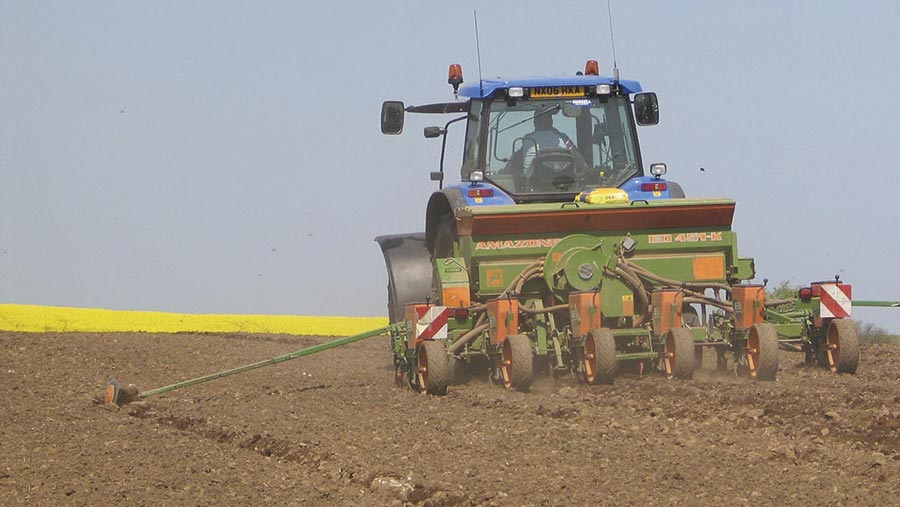How reducing maize seed rates could save money and lift starch

Cutting maize seed rates by 5-10% has the potential to lift starch levels by 2-3% and bring harvest date forward by three to five days, according to John Burgess, maize product manager at KWS.
The revised approach to seed rates was largely fuelled by environmental concerns, following several consecutive seasons of difficult harvests and has been accompanied by a successful move by breeders to develop earlier maturing hybrid varieties.
“A reduced seed rate is just one tool in the toolbox, as growers seek to maximise yields from forage and minimise the environmental impact of their crops, particularly soil structure damage.
“But it is no substitute for good husbandry and correct choice of site,” says Mr Burgess.
See also: 6-step guide to successful maize establishment
Conventional rates are benchmarked at 110,000 seeds/ha (45,000 seeds/acre); equivalent to 2.3 units/ha, based on a standard 50,000 seed pack. This produces a population of 11 plants/m2.
Under these new practices seed rates can be trimmed back by 5% which means drilling at 90-100,000 seeds/ha (40-42,000 seeds/acre). This is equivalent to 1.9-2 units/ha and includes a 5% allowance for projected losses, to give 9-10/ plants/m2.
This is equivalent to 1.9-2 units/ha and includes a 5% allowance for projected losses, to give 9-10/ plants/m2.
To achieve this target in practice relies more on the drilling precision capability of modern machinery than on seed quality, Mr Burgess says.
He adds that the manipulation of plant numbers should be viewed as a management tool for growers to try, perhaps on a field-by-field basis, to fine-tune and adapt the crop to heavier or lighter fields.
Benefits of reducing maize seed rate
Mr Burgess says the main driver for reducing seed rate is to permit the crop to intercept more light, thereby boosting grain content and overall silage quality.
“Another advantage is that each plant will have access to more water, to sustain fresh weight yields in low rainfall areas, or in a dry season,” he says.
“Growth regulators are not used for forage maize, as the crop is unique in its ability to establish, develop and mature the plant in response to the seedbed structure and plant population created by the grower.”
Increased access to sunlight also causes plants to mature rapidly, which offers the opportunity of later drilling; possibly at the end of May or early June. With the ultra-early FAO 150-160 varieties, drilling can be extended, particularly for growers wishing to follow early-lifted crops.
Managed correctly, delayed drilling has the added benefit of reducing maize establishment costs.
“A pre-emergence herbicide can be replaced with the cheaper option of glyphosate, applied to the stale seedbed,” says Mr Burgess.
“Plants will get off to a better start, because they will emerge rapidly from higher soil temperatures of 12-15C.
But it should be noted that for every week that drilling is held off, about 7-10 days will be lost in September and October. What is lost in heat units must be clawed back in light interception.”
Reduction limits
Despite the new recommendation, too severe a reduction carries the risk of losses, he warns.
“I would not recommend going any lower than 85,000 seeds/ha for silage, or 75,000 for grain maize. Below this, even the earliest of varieties will produce disappointing dry matter yields, as the crop will not be able to make up for the lack of plant numbers.”
Grower case study
Ed Perraton aims for a high quality maize silage crop for his dairy herd at Winslade Farm near Kingsbridge, south Devon.
He discovered the merits of seed rate manipulation by accident in 2015, when he came close to running out of supplies while his contractor was sowing at 104,000 seeds/ha (42,000 seeds/acre).
The seed rate was adjusted down and records showed that these fields out-performed the conventionally sown crops.
“The results encouraged me to adopt the same system last year, when I planted two varieties at 94,000 seeds/ha (38,000 seeds/acre),” says Mr Perraton.
“I arrived at the figure as a mid-range, low seed rate option and it will be repeated this season.”
“The greatest effect has been bigger cobs and therefore higher starch, which used to average 32%, but has risen to 38% using lower seed rates, although I will admit that 2016 was a very good year. This has been achieved without any penalty on yield.”
Winslade Farm facts
- 200 Holstein Friesians
- Yield average 10,500kgs
- Cows housed AYR
- Partial TMR diet, with concentrates fed in robots
- Favourable growing conditions – light, Devon red soil, with south-facing fields at sea-level
